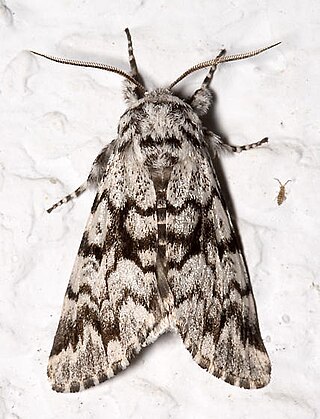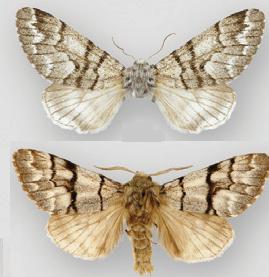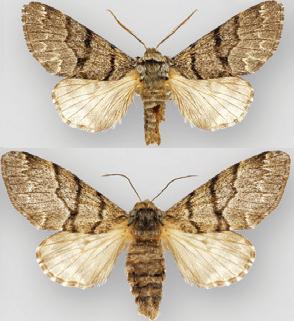
Hermit crabs are anomuran decapod crustaceans of the superfamily Paguroidea that have adapted to occupy empty scavenged mollusc shells to protect their fragile exoskeletons. There are over 800 species of hermit crab, most of which possess an asymmetric abdomen concealed by a snug-fitting shell. Hermit crabs' soft (non-calcified) abdominal exoskeleton means they must occupy shelter produced by other organisms or risk being defenseless.

The genus Coenobita contains 17 species of terrestrial hermit crabs. Several species in this genus are kept as pets.

The dot moth is a moth of the family Noctuidae. The species was first described by Carl Linnaeus in 1761. It is a very distinctive species with very dark brown, almost black, forewings marked with a large white stigma from which the species gets its common name. The hindwings are grey with a dark band at the termen. The wingspan is 38–50 mm. It flies at night in July and August and is attracted to light, sugar and flowers.

Saturnia pyri, the giant peacock moth, great peacock moth, giant emperor moth or Viennese emperor, is a Saturniid moth which is native to Europe. The species was first described by Michael Denis and Ignaz Schiffermüller in 1775. It is the largest European moth, with a wingspan reaching 15–20 cm (6–8 in).

Aprostocetus is a genus of hymenopteran insects of the family Eulophidae. The genus was erected by John O. Westwood in 1833. This very large group of parasitoid wasps has a global distribution.

Phragmatobia fuliginosa, the ruby tiger, is a moth of the family Erebidae.

Euplagia quadripunctaria, the Jersey Tiger, or Spanish Flag, is a day-flying moth of the family Erebidae. The species was first described by Nikolaus Poda von Neuhaus in 1761. The adult wingspan is 52–65 millimetres (2.0–2.6 in), and they fly from July to September, depending on the location. They tend to fly close to Eupatorium cannabinum.

Laothoe amurensis, the aspen hawk-moth, is a moth of the family Sphingidae.

Watsonarctia is a monotypic moth genus in the subfamily Arctiinae erected by Josef J. de Freina and Thomas Joseph Witt in 1984. Its only species, Watsonarctia deserta, the chaste pellicle, was first described by Max Bartel in 1902. It is found in central and south-eastern Europe, southern Russia, southern Siberia east to Lake Baikal; also in Asia Minor, Armenia, Azerbaijan, northern Iran, Kazakhstan, Kyrghyzstan and Xinjiang in China.

Panthea acronyctoides, the black zigzag or tufted spruce caterpillar, is a moth of the family Noctuidae. The species was first described by Francis Walker in 1861. It is found in North America from Newfoundland to British Columbia and adjacent northern states, south in the west to Colorado, south in the east to New England and Kentucky.

Panthea furcilla is a species of moth of the family Noctuidae. It is found across the boreal forest region of Canada west to the Rocky Mountains, and in the eastern parts of the United States, from Maine to Florida, west to Texas, north to Indiana and Ohio.

Theresimima is a genus of moths. T. ampellophaga, the vine bud moth, is a moth of the family Zygaenidae. It is found from Algeria, Spain and southern France through most of southern Europe to the northern coast of the Black Sea. In the north, it ranges up to Hungary and Slovakia and in the east, the range extends to the southern part of European Russia, the western Caucasus and Transcaucasia, through Turkey, Lebanon and Syria to Israel.

Panthea is a genus of the owlet moth family, Noctuidae. The word Panthea is from Greek, meaning "all of gods".

Panthea guatemala is a moth of the family Noctuidae. It has been collected in the mountains of Guatemala and the states of Oaxaca and Chiapas in adjacent southern Mexico at elevations of 1580–1850 m.

Panthea greyi is a moth of the family Noctuidae. It has been collected in the mountains of Arizona, New Mexico, Colorado and southern Utah, at elevations of 1524–2545 m.

Panthea virginarius, the Cascades panthea, is a moth of the family Noctuidae. It is mainly found west and north of the Great Basin, from the coast of southern California northward to the Queen Charlotte Islands of British Columbia and the Alaskan Panhandle, eastward to central California, northern Nevada, Idaho, north-western Wyoming, western Montana, and south-western Alberta. A disjunct population is found in the Cypress Hills of Alberta and Saskatchewan.

Heliothis ononis, the flax bollworm, is a moth of the family Noctuidae. The species was first described by Michael Denis and Ignaz Schiffermüller in 1775. It is found in China, Kazakhstan, central Asia, northern Mongolia (Khangai), the Russian Far East, the Korean Peninsula, southern European part of Russia, southern and central Europe, southern and eastern Siberia and Turkey. In North America it is found from south-central Manitoba west to British Columbia, north to the Northwest Territories and Yukon and Alaska and south to Colorado.

Scopula virgulata, the streaked wave, is a moth of the family Geometridae. The species was first described by Denis & Ignaz Schiffermüller in 1775. It is found from most of Europe to central Asia and northern Mongolia.

Acossus terebra is a species of moth of the family Cossidae. It is found in Eurasia, including Israel, Turkey, northern Spain, central and southern Europe, southern Sweden, Finland, the Baltic region, Ukraine, the central part of European Russia, the Caucasus, southern Siberia to southern Yakutia, the southern part of the Russian Far East, Korea, Heilongjiang, Jilin and inner Mongolia.
Psoricoptera speciosella is a moth of the family Gelechiidae first described by Karl August Teich in 1892. It is found from northern and central Europe south to France, northern Italy and Romania. It is also found in the European part of Russia, Siberia, the Russian Far East and Japan.


















